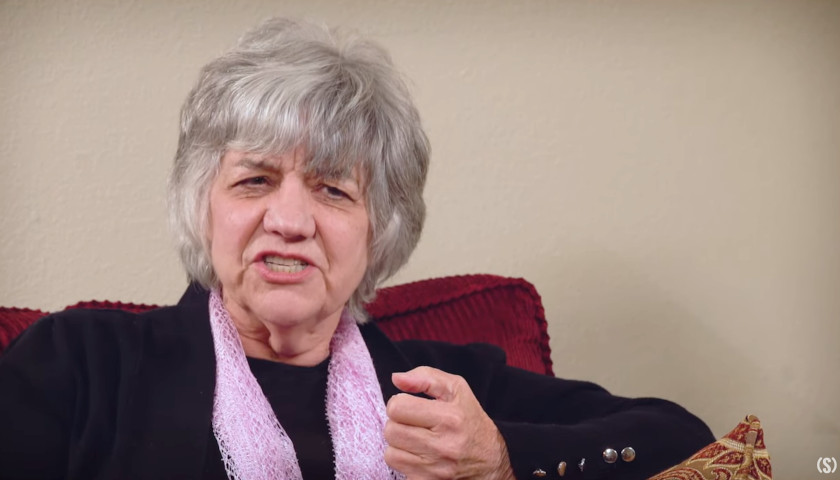by Kelsey Bolar
LANDER, Wyo.—Sue Ellen Browder wrote fake news before “fake news” was ever a thing. Except she prefers not to call it that—not because she’s embarrassed to admit she wrote fake news (although she’s certainly not proud), but because she thinks the term “fake news” is too vague to understand.
Browder, a Cosmopolitan magazine writer for 20 years, describes what she wrote as “propaganda.”
The goal? To sell women on the idea that sexual liberation is the path to the single woman’s personal fulfillment.
“Propaganda is very sophisticated,” Browder tells The Daily Signal. “It’s half-truth, selected truth, and truth out of context.”
“Propaganda is used not to sell just products,” she adds. “It’s also used to sell ideas.”

Prior to writing for Cosmopolitan, Browder worked at a small daily newspaper, the South Bay Daily Breeze, just outside Los Angeles. When she and her husband unexpectedly got pregnant, they were far more excited about it than her bosses at the newspaper were.
“They told me I could only work five months into my pregnancy and then I had to quit,” Browder recalls.
That experience turned Browder, who was born and raised in small-town Iowa, into a feminist.
The year was 1969, and getting fired for being pregnant was a wake-up call. The situation made Browder, who graduated from the Missouri School of Journalism, realize that women had quite a bit of work to do.
“Women could not apply for credit in [their] own name. There were ‘help wanted’ ads—help wanted male and help wanted female,” she says. “Women couldn’t go to law school or medical schools in many cases. There was a lot of discrimination going on. And that is why in the late ‘60s and early ‘70s, so many women of my generation identified with the feminist movement.”
Being a feminist back then was very different from what it means today, when many perceive the movement as anti-male and pro-abortion.
“The feminist movement was fighting for equal opportunity for women in education and the workforce,” Browder says of its early roots. The sexual revolution, on the other hand, “was fighting for all sorts of sexual freedoms.”
So how did the two become so intertwined? In part, Browder says, through the propaganda she wrote.
Beginning in 1971, Browder worked under the legendary Helen Gurley Brown, who was Cosmopolitan’s editor-in-chief for more than 30 years and author of the bestselling 1962 book “Sex and the Single Girl.”
Taking cues from Playboy magazine, Brown turned the struggling magazine into an international empire. She gave her writers a printed list of rules to follow, which included instructions about how to make up parts of their stories to sound more convincing.
Browder still owns her original copy of the rules today. Flipping through the pages, she reads two examples out loud:
Unless you are a recognized authority on the subject, profound statements must be attributed to somebody appropriate, even if the writer has to invent the authority. …
Try to locate some of the buildings, restaurants, nightclubs, parks, streets, as well as entire case histories … in cities other than New York, even if you deliberately have to plant them elsewhere. Most writers live in New York, 92% of our readers do not.
By planting salacious stories about women having extravagant affairs in places such as Cleveland and Des Moines, Browder says, “the magazine spread its mores throughout the country and throughout the culture by pretending that they were much more widespread than they actually were.”
One of those Cosmo mores was the idea that abortion was a woman’s “right,” years before the Supreme Court ruled it a constitutionally protected right.
Browder details the story of how a small group of feminists inserted abortion into the agenda of the women’s movement in her 2015 book “Subverted: How I Helped the Sexual Revolution Hijack the Women’s Movement.” She documents the disgust of many pro-life feminists.
But from that point on, the narrative was set.
“Essentially, ‘All women want this.’ And that is how propaganda works,” Browder says.

While Browder was married and living a traditional lifestyle quite different from what she was espousing in Cosmopolitan, she, too, was corrupted by its influence. At one point, the ideas in those pages seeped into the most personal decision she and her husband could ever make.
At 27 years old, Browder was happily married with two children at home. When she became pregnant with a third, she and her husband decided to get an abortion. It was 1974, the year after Roe v. Wade.
Browder, who lived in the Los Angeles area and later in two parts of Connecticut for most of her time writing for Cosmo, says she had the abortion in the same hospital where she previously gave birth.
“I did not realize what a traumatic experience that would be later in my life, how much that would haunt me.”
About 20 years later, in 1994, Browder’s last piece appeared in Cosmopolitan. About 10 years after that, she converted to Catholicism and sought the help of the church to heal her from the abortion.
“When you start betraying the truth, it will come back to haunt you,” she says. “It will get you in the end. And that’s why even though I knew we were making up stories, I still got sucked in and thought abortion would be OK.”
Browder’s abortion isn’t the only thing she has sought forgiveness for. In her book, she comes clean about the propaganda she wrote for Cosmopolitan, despite its casting an embarrassing shadow over her career as a journalist.
“I don’t want to take more credit than I deserve for all this evil, but I think that I—I was certainly part of the evil empire, if you will,” she tells The Daily Signal. “And what I would like … for young women today [is] to tell them the truth so they could see how my generation got it wrong, why we got it wrong, and how they can do better. How, how your generation can do better.”
In order to do better, Browder says, pro-life women must reclaim the feminist movement for themselves.
“There is such a thing as pro-life feminism and … in fact, pro-life feminism is the authentic feminism of the 21st century,” she says.
But reclaiming feminism won’t be easy, she adds. It will require girls and young women to reject the ideas being sold to them in the pages of Cosmopolitan and almost everywhere else.
“Why all this hijacking of the women’s movement?” Browder asks. “Money.”
“Why was Cosmo so successful? Because it attracted advertisers. Why did it attract advertisers? Because it worked. When a young woman, an insecure young woman, reads these magazines and thinks that she has to have perfume, cosmetics, hair products, beautiful clothes, singles travel … abortions, contraception, when she thinks she has to have all of these things, she’s going to spend a lot of money.”
Browder adds:
They’re telling you on the one hand, ‘Be yourself;’ on the other hand, they’re saying, ‘You’re not good enough the way you are, buy all this stuff to be beautiful.’ Why aren’t you beautiful just the way you are?
‘Here’s the perfume. Oh yeah, you stink too. Oh, by the way, your hands don’t look very nice either. And your hair color is wrong. Oh, and when you’re tired of hearing about that, have some ice cream and a little booze to go with it, because then you’ll be too fat and then we’ll have to put you on a diet.’
Sitting in her bare apartment without the slightest bit of makeup on, Browder, now 74, giggles at the ridiculousness of the ideas that she once told women were the secret to happiness and success.
But then she turns serious, reflecting on the damage she’s done and the damage such magazines and websites continue to do.
“Now there’s the other side of it. I say we’re all liberated. Are we?” she asks. “On one hand, yes. We can go to college. We can get a degree. We can be doctors, lawyers, engineers. We can do all this stuff. We can make all this money.”
“But,” Browder pauses, looking at the iPhone on her kitchen table, “how liberated are we if our girls have got that in their pockets before they can even think?”
To learn more about Sue Ellen Browder’s story, check out her book “Subverted: How I Helped the Sexual Revolution Hijack the Women’s Movement.”
– – –
Kelsey Bolar is a senior writer and producer at The Daily Signal and a senior policy analyst at Independent Women’s Forum.
Photo “Sue Ellen Browder” by Daily Signal.




